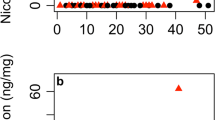Abstract
We carried out two experiments to determine the effect of leaf damage on plant attractiveness to pollinators using wild radish, Raphanus raphanistrum (Brassicaceae), a self-incompatible annual herb. Pairs of plants from 36 full-sib families were grown in pots in the greenhouse. One member of each pair was damaged by Pieris rapae larvae that were allowed to remove half of the leaf area of each of the first four rosette leaves. The plants were subsequently taken out for pollinator observations once a week from the beginning of flowering in late June until the end of August. We conducted two experiments to examine how foliar damage affected visitation by pollinators. In the first experiment, numbers of pollinators visiting plants were compared between damaged and control sibling plants. In the second experiment, the number of open flowers during observations was controlled to be the same for both damaged and undamaged sibs. Damage significantly decreased the number and size of flowers during the first observations in late June. Damaged plants received fewer visits by native bees during the first week of observations. Since damage did not affect native bee visits when the number of open flowers was equalized between treatments, flower number was probably the main cue attracting native bees to plants. In the experiment without flower number control, syrphid flies, the other abundant pollinator taxon, spent more time per flower on the undamaged than on the damaged plants. When flower number was controlled, flies probed significantly more flowers during each visit on the undamaged than on the damaged plants and had higher visitation rates to undamaged plants early in the season. Since syrphid flies preferred undamaged plants both with and without flower number control, they apparently used cues apart from flower number for visitation. The difference between undamaged and damaged plants in floral characteristics and pollinator visitation vanished within a few weeks after the start of flowering. This result suggests that early damage may not have a strong fitness effect through reduction in mating success. However, poor weather conditions can cause early mortality of plants in the field, and nutrient depletion and competition decrease fruit set of later flowers. Therefore, conditions exist under which visitation to early flowers may affect plant fitness.
Similar content being viewed by others
Author information
Authors and Affiliations
Additional information
Received: 30 July 1996 / Accepted: 10 February 1997
Rights and permissions
About this article
Cite this article
Lehtilä, K., Strauss, S. Leaf damage by herbivores affects attractiveness to pollinators in wild radish, Raphanus raphanistrum . Oecologia 111, 396–403 (1997). https://doi.org/10.1007/s004420050251
Issue Date:
DOI: https://doi.org/10.1007/s004420050251




